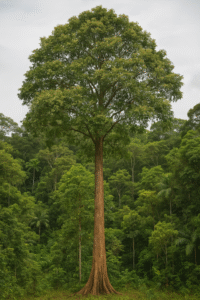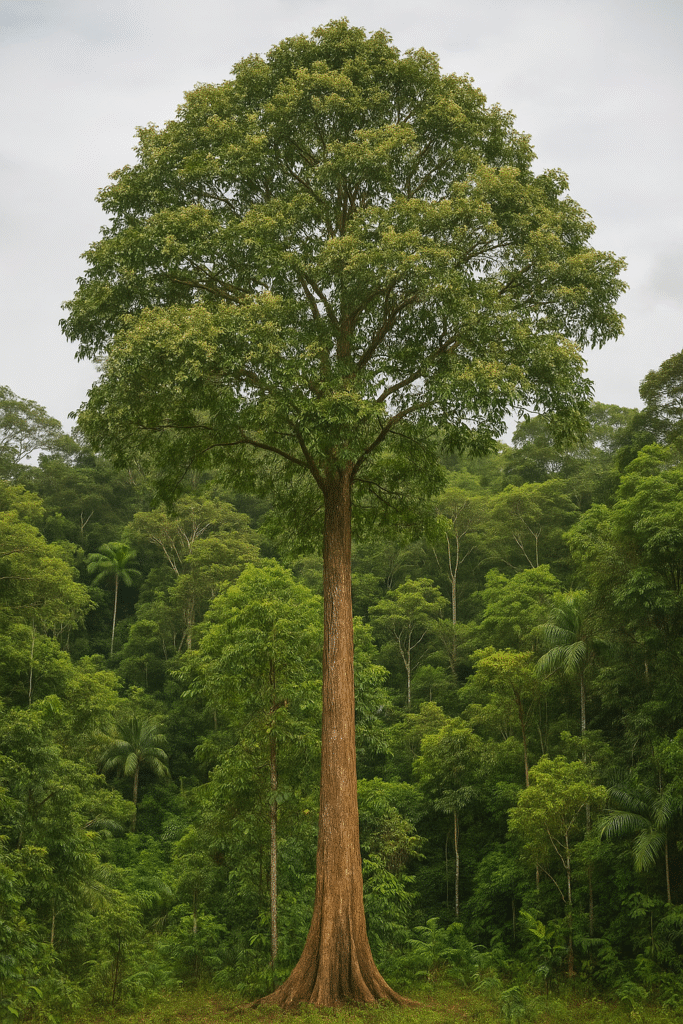Rosewood (Aniba rosaeodora) is a tree native to the Brazilian Amazon, commonly found in the states of Amazonas, Acre, and Pará. Known for its sweet fragrance and valuable wood, this tropical species played a historic role in the global perfume industry and continues to attract attention for conservation efforts, botanical research, and even eco-tourism.
In this article, you’ll learn about the features, uses, curiosities, and environmental challenges surrounding rosewood, as well as why it’s so valuable and how nature lovers can interact with it responsibly.
Characteristics of Rosewood
The rosewood tree can grow up to 25 to 35 meters tall, with a straight trunk and dense crown. Its name comes from the pleasant, rose-like aroma released by its wood, which is highly unique and was once a symbol of the high-end fragrance industry in the 20th century.
The essential oil is obtained through steam distillation of the wood (and sometimes the leaves), and is rich in linalool, a compound extensively used in fine perfumery and cosmetics. Renowned brands such as Chanel and Guerlain featured this oil in their classic formulas, making rosewood a strategic natural resource during the last century.
Habitat and Ecological Importance
Rosewood grows in humid tropical forests, often near rivers. It plays a vital role in the local ecosystem, supporting biodiversity by providing shelter and food to birds, insects, and small mammals.
Moreover, the tree contributes to the ecological richness of the Amazon, acting as one of many examples of Brazil’s still largely unexplored botanical heritage.
Commercial Exploitation and Endangerment
For decades, rosewood was heavily exploited, resulting in a sharp decline in natural populations. Unsustainable extraction, mainly for essential oil export, led to ecological imbalance and placed the species at risk of extinction.
Today, rosewood is protected by environmental laws and listed under the CITES (Convention on International Trade in Endangered Species of Wild Fauna and Flora). Its logging and transportation are only allowed with proper authorization from Brazilian authorities like IBAMA.
Fortunately, in recent years, projects focusing on sustainable cultivation and less harmful extraction methods—such as using leaves instead of trunks—have been gaining ground, promoting both conservation and responsible use of the species.
Observing Rosewood in Nature
Nature lovers and birdwatchers may come across rosewood trees while hiking through protected areas or ecological reserves in the Amazon.
During flowering seasons, the tree attracts a variety of hummingbirds, butterflies, and native bees, creating a stunning visual and auditory experience. This interaction between flora and fauna is a delight for photographers, biologists, and eco-tourists alike.
For those who plan to explore these forests and observe rosewood and surrounding wildlife, having the right gear is essential. A pair of high-power binoculars is ideal for spotting details from a distance without disturbing the natural environment.
Fun Facts About Rosewood
-
The scientific name Aniba rosaeodora reflects its rose-like scent.
-
Its essential oil is still used today, though under strict international controls.
-
Sustainable cultivation in nurseries is encouraged by NGOs and research institutions.
-
Many birds nest in its branches, making it a prime interest for birdwatchers.
-
It was one of the first Amazonian trees to gain attention from the European perfume industry in the 19th century.

A Call for Conscious Observation
If you’re passionate about ecology, tropical trees, and the wonders of the Amazon, exploring rosewood up close—respectfully and sustainably—can be an unforgettable experience.
Recommended Gear for Nature Observation:
High-Power 10×50 Binoculars for Birdwatching
-
HD optical system for maximum clarity
-
Non-slip grip for safe handling even in wet conditions
-
Waterproof and built for outdoor adventures
Explore the richness of the forest and observe rosewood in its natural setting with the right tools and a deep respect for nature.
🌿 Discover Another Botanical Gem!
If you’re fascinated by rare and aromatic trees like Rosewood, you’ll enjoy learning about Canela-Sassafras – a botanical treasure from Brazil’s Atlantic Forest, rich in history, traditional uses, and ecological value.

